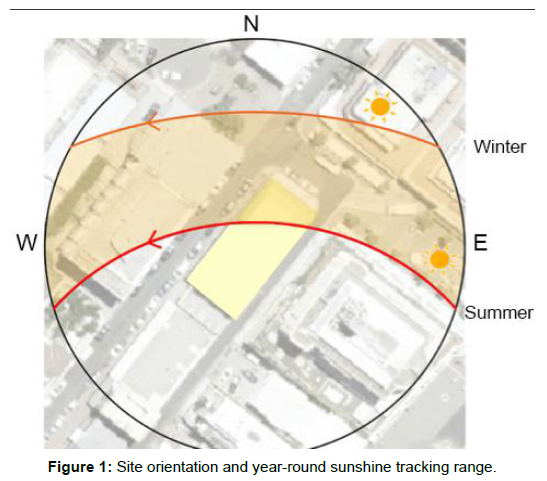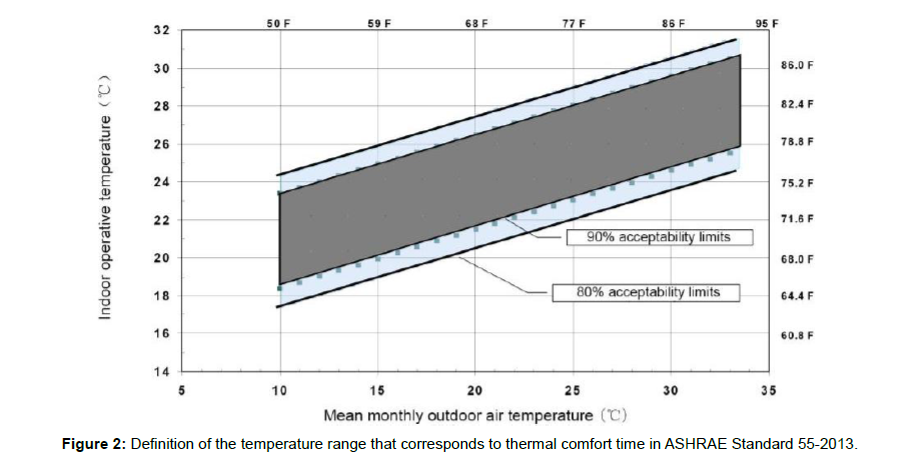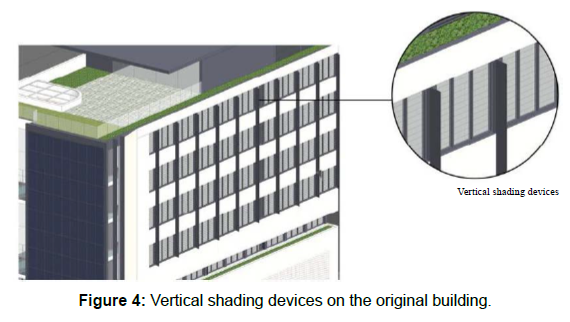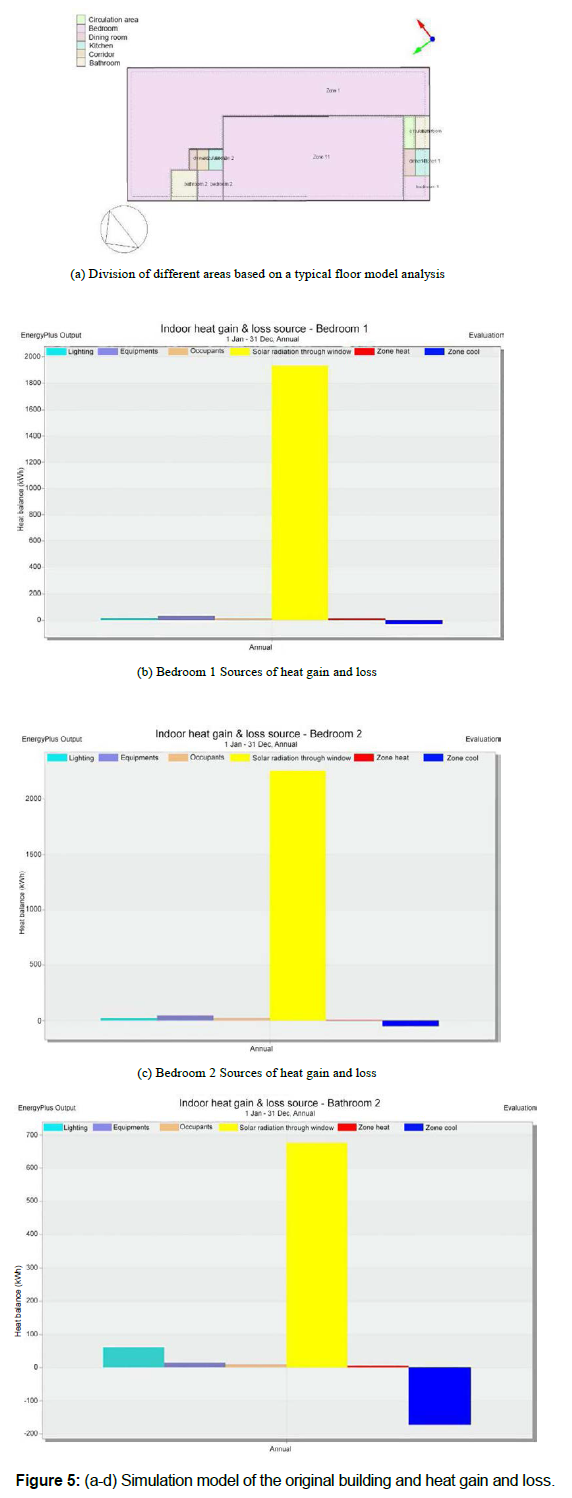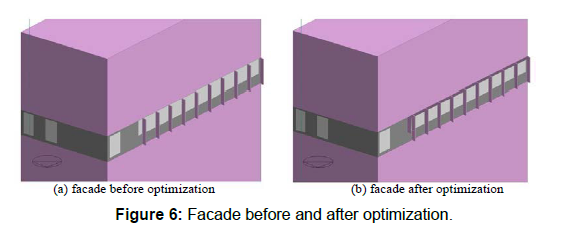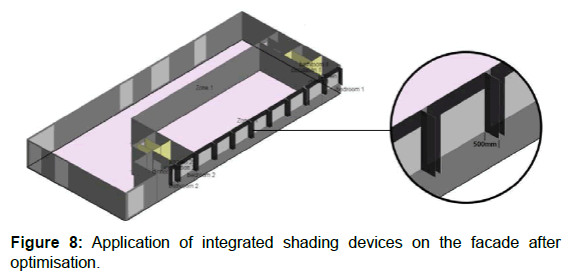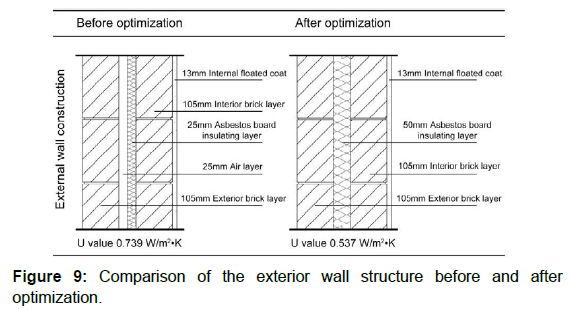Influence of the Passive Design of a Building Facade on the Indoor Thermal Comfort of Residential Buildings
Received: 24-Sep-2018 / Accepted Date: 01-Oct-2018 / Published Date: 11-Oct-2018 DOI: 10.4172/2168-9717.1000218
Abstract
Building facades have evident effects on indoor thermal comfort. Hence, on the basis of a multifunctional residential building in Sydney, Australia, this research uses Design Builder software to optimise passive system design on building facades. This research also analyses the influences of changing window glazing type, adding additional shading devices and changing the material of the exterior wall on indoor thermal comfort. Results show that the number of uncomfortable hours can be reduced by 446, 186 and 874 hours by using a double-layer Low-E glass, adding extra shading device and adopting an external wall material with low thermal conductivity, respectively. When the three aforementioned passive design strategies are combined, indoor thermal environment discomfort time can be reduced by 24%. Therefore, the indoor thermal comfort of a building can be considerably improved through effective passive designs of the building facade.
Keywords: Building façade; Indoor thermal comfort; Design builder; Window glazing; Shading device; Exterior wall materials
Introduction
The operation stage of building accounts for a higher proportion of its entire life cycle compared with the architecture design and construction stages. Therefore, energy consumption during a building’s operation stage comprises a major part of its energy consumption in its entire life cycle [1]. With the global energy crisis becoming increasingly serious, ensuring and improving indoor thermal comfort whilst reducing energy consumption during a building’s operation stage are important goals [2]. At present, energy conservation in most buildings is focused on reducing energy consumption, whereas indoor thermal comfort is less frequently considered [3]. Building facades affect indoor thermal comfort. The dual effects of reducing building energy consumption and improving indoor thermal comfort can be achieved by adopting a passive design in a reasonable manner. In this study, a passive design is applied to a multifunctional residential building in Sydney, Australia to optimize its facade. The computer simulation software Design Builder is used to simulate indoor thermal comfort during the operation stage [4]. Corresponding passive construction optimization strategies are proposed based on the analyses of factors that influence the original indoor thermal comfort of a building. Subsequently, indoor thermal comfort is simulated and analysed after adopting passive optimization strategies. Without increasing energy consumption, passive design strategies on the facade are optimized and the indoor thermal comfort of the building is improved. This study provides references for the design and construction of local buildings of the same type.
Project Overview
A multifunctional residential building with eight stories located in Bondi Beach (33°89ʹS, 151°27′E) is selected as the research case. The project location exhibits the characteristics of a subtropical humid monsoon climate. The annual mean temperature in the region is 20.7°C. July is the coldest month, with a mean temperature of 8°C. January is the warmest month, with a mean temperature of 19°C [5]. As shown in Figure 1, the building faces northwest, with an area of 2961 m2. Natural ventilation is adopted in the entire building, with no heating or refrigeration equipment. The building design meets the requirements of the Building Codes of Australia (BCA). This study develops optimization design based on three factors that are closely related to building facades: facade glazing, shading devices and exterior wall materials. This study also uses Design Builder software for quantitative simulation analysis and the comparison of indoor thermal comfort before and after implementing the optimization design. Meanwhile, the new building energy efficiency design standard 55-2013 [6] issued by the American Society of Heating, Refrigerating and Air-Conditioning Engineers (ASHRAE), which stipulates that the total time should be within the acceptable temperature range, is used to evaluate indoor thermal comfort as in Figure 2. Thermal comfort is the mental state that shows satisfaction with the thermal environment. It is evaluated based on the ASHRAE Standard, which points out that in a neutral environment (i.e. wind speed lower than 0.2 m/s, indoor humidity of 50%), the comfortable temperature range during winter is 20-24°C and that during summer is 24-27°C. However, this standard is influenced by individual activities, clothing and outdoor temperature and humidity. Therefore, inhabitants living under natural ventilation are more likely to accept a wider temperature range, combine indoor comfortable temperature with outdoor temperature, and define 80% and 90% acceptability limits as satisfactory temperature range. On the basis of an experimental analysis, the aforementioned range is the range of thermal comfort, and any point outside this range will cause thermal discomfort. In the current experiment, the total time of indoor thermal comfort of a building with natural ventilation is used as the test datum, and the satisfactory range for 90% acceptability of the inhabitants in ASHRAE Standard 55-2013 is adopted as the acceptable temperature range. A software analysis is performed based on the satisfactory temperature range for 90% of the inhabitants in ASHRAE Standard 55-2013. A conclusion is drawn that in the satisfactory temperature range, the uncomfortable time that does not meet this criterion is the uncomfortable time of the indoor thermal environment.
Influence of Building Facade on Indoor Thermal Comfort
Building facades are directly exposed to the external environment. Different building facades are related to varying indoor comfort and energy consumption levels. A reasonable facade design helps reduce energy consumption and improve indoor thermal comfort [7]. Therefore, the passive design of building facades is an important aspect in managing building energy consumption [8]. As shown in Figure 3a and 3b, the building has a concrete frame structure with sand-coloured facing bricks. A coffee shop and stores that provide direct public services are located in the empty space on the ground floor. The first and second floor contains an auditorium for 150 people and offices for community parties and meetings. The third and higher floors are typical floors for residences, where each floor is composed of eight single apartments and a public activity area. The building faces northwest; hence, an analysis of the typical floor plan of the original building shows that a considerable amount of solar radiation is absorbed in the afternoon. To reduce the accumulation of solar radiation, vertical shading devices are included in the original design, as shown in Figure 4. In Design Builder, division is implemented based on the actual building design parameters and functions, and modelling is performed for the selected typical floor plan. The properties used in each area are defined, as shown in Figure 5a. Simulation analysis on the indoor thermal comfort of the original building indicates that the major factor that influences indoor thermal comfort is the excessive accumulation of solar radiation through the facade, particularly through the external window, as shown in Figure 5. On the basis of the building orientation and using unchanged functions, optimization design is implemented on elements of the typical floor facade, as shown in Figures 6 and 7. Optimization design includes replacing the common single glass with Low-E double glass for the external window, adding horizontal shading devices to the vertical shading devices, forming integrated shading devices and replacing facade materials to decrease the heat conductivity coefficient.
Passive Design Strategy on the Façade
The aforementioned simulation analysis of the original building indoor thermal comfort shows that heat that causes indoor thermal discomfort is mostly due to direct solar radiation through the facade. The optimization of passive design can effectively improve the heatinsulating performance of the external part of the building. The influence of indoor overheating due to direct solar radiation on indoor thermal comfort can be enclosed and reduced.
Changing window glass type
The original building uses a common single glass, which is similar to those used in most local residential buildings. Common single glass exhibits an evident shortcoming of having a high U value (5.88 W/ m2•K) and cannot effectively block heat brought by long-wave light [9]. To reduce heat gain due to solar radiation, the optimization design adopts a Low-E glass coating, which demonstrates excellent thermal barrier effect and outstanding light-admitting quality with a high reflection of medium-distance and far infrared rays. After optimization, the air layer of Low-E double-layer glass is 13 mm thick, and the glass is 6 mm thick. The heat conductivity coefficient of the external window is reduced from 5.88 W/m2•K to 1.67 W/m2•K when the common single glass is replaced with Low-E double glass. As shown in Table 1, the heat gained through the external window after optimization is reduced, and the total time of indoor thermal discomfort for the entire year decreases from 6286.5 h to 5840.5 h, which accounts for 7.1%.
| Before Optimization | After Optimization | |
|---|---|---|
| Bedroom 1 | 945.5 | 810 |
| Bedroom 2 | 335 | 220 |
| Dining room 1 | 677.5 | 592.5 |
| Dining room 2 | 639.5 | 554.5 |
| kitchen 1 | 531.5 | 498.5 |
| Kitchen 2 | 563 | 564 |
| Corridor 1 | 664 | 665 |
| Corridor 2 | 936 | 896.5 |
| Bathroom 1 | 619 | 639 |
| Bathroom 2 | 375.5 | 400.5 |
| Total | 6286.5 | 5840.5 |
Table 1: Comparison of time of indoor thermal discomfort under different external glass conditions (unit:h).
Addition of shading devices
In addition to changing the external window glass type, installing reasonable shading devices on the external wall can also reduce the negative influence of solar radiation on indoor thermal environment. The simulation analysis indicates that using only the vertical shading method cannot provide a satisfactory shading effect; therefore, horizontal shading devices are added to the optimization design. Consequently, integrated shading is adopted. As shown in Figure 8, the horizontal and vertical shading baffles have a ledge size of 500 mm. With the adoption of integrated shading based on the software simulation statistics, the total time of indoor thermal discomfort for the entire year is reduced by 186 h, which accounts for 3%.
Optimization of building facade wall materials
In addition to the window glazing and shading devices, another important element of the facade is the external wall. The entire building adopts a reinforced concrete structure, with double brick external walls and external thermal insulation. In the original building design, a 25 mm asbestos board insulating layer and a 25 mm air layer are adopted as shown in Figure 9. With an increase in thermal insulating layer thickness, the thermal performance of the external wall can be improved to a certain degree. The thickness of the asbestos board insulating layer is increased from 25 mm to 50 mm, thereby cancelling the air layer.
Hence, the thermal performance of the external wall is considerably improved. The simulation analysis on indoor thermal comfort after optimization indicates that the total time of indoor thermal discomfort for the entire year is decreased by 874 h, which accounts for 14%.
Conclusion
With the three passive designs on building facades, namely, doublelayer Low-E glass, shading devices and exterior wall materials, the total time of indoor thermal discomfort for the entire year is reduced by 1,506 h, which accounts for 24%. When double-layer Low-E glass is used, the total discomfort time is reduced by 446 h (accounting for 29.6% in total reduction time). When shading devices are added, the total discomfort time is reduced by 186 h (accounting for 12.4% in total reduction time). When exterior wall materials with a low heat conductivity coefficient are used, the total discomfort time is reduced by 874 h (accounting for 58% in total reduction time). Therefore, the choice of external wall materials exerts a considerable influence on indoor thermal comfort. Furthermore, the indoor thermal comfort of existing buildings can also be improved by changing the external window glass type and adding shading devices. The results of this research provide a technical reference for local residential building design and construction.
References
- Lewis A, Riley D, Elmualim A (2010) Defining High Performance Buildings for Operations and Maintenance. International Journal of Facility Management 1: 145-156.
- Jian X, Jin Z, Feng X, Guo-qiang Z (2012) Evaluation index for indoor thermal environment of residential buildings based on thermal comfort in hot summer and cold winter zone. Journal of Central South University 43: 3693-3697.
- Zhifeng W, Liding C (2016) Thermal Comfort Evaluation and Urban Thermal Environment Study. Journal of Ecology 35: 1364-1371.
- Huanhuan Y (2010) Passive Design Strategy of Public Building Transition Space of climate in Areas Warm in summer and Cold in winter. Chongqing: Chongqing University.
- ASHRAE Standard 55-2013. Thermal Environment Conditions for Human Occupancy. Bondi Beach Climate, Averages and Extreme Weather Record[S].
- Ajla A (2015) Design Methods For Sustainable, High-Performance Building Facades. Advances in Building Energy Research 10: 240-262.
- Aksamija A (2015) High-Performance Building Envelopes: Design Methods for Energy Efficient Facades.
- Hairong X (2007) Theoretical Analysis and Experimental Study on Energy Consumption of Filmed Window Glass. Changsha: Hunan University.
Citation: Pengfei Z, Chi Z (2018) Influence of the Passive Design of a Building Facade on the Indoor Thermal Comfort of Residential Buildings. J Archit Eng Tech 7: 218. DOI: 10.4172/2168-9717.1000218
Copyright: © 2018 Pengfei Z, et al. This is an open-access article distributed under the terms of the Creative Commons Attribution License, which permits unrestricted use, distribution, and reproduction in any medium, provided the original author and source are credited.
Share This Article
Recommended Journals
Open Access Journals
Article Tools
Article Usage
- Total views: 4318
- [From(publication date): 0-2018 - Apr 03, 2025]
- Breakdown by view type
- HTML page views: 3511
- PDF downloads: 807

